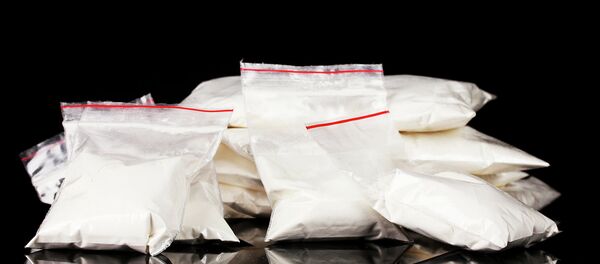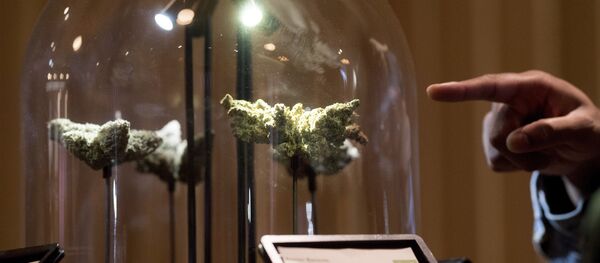Synthetic marijuana isn't a single substance, but a collection of products sold under brand names like K2, Spice, AK-47, Mr. Happy, Scooby Snax, Kush and Kronic, NPR noted.
Since July 14, the DC Fire and EMS Department has received 463 calls for suspected K2 overdoses, spokesperson Douglas Buchanan told NPR, of whom 340 were transported to area hospitals with symptoms of K2 ingestion.
Adam Eidinger, a legalization activist with Maryland Marijuana Justice, urged, "Don't buy this stuff," when he spoke with Radio Sputnik's By Any Means Necessary on Wednesday. "People should go cold turkey and stop."
Strange words, perhaps, from a marijuana advocate, but synthetic marijuana is not, in fact, marijuana at all, but rather "a potpourri of herbs that are dried and then sprayed with a synthetic," Eidinger noted to hosts Eugene Puryear and Sean Blackmon.
"It's sold at gas stations, corner stores and tobacco shops," David Barnett, a delivery driver in the District, told NPR recently. "I see the empty wrappers everywhere."
The synthetic, often marketed as incense of the kind used in altars or religious rituals, not burned in a stick, was a good little earner at his store in the not-too-distant past, Eidinger said.
"We told people not to smoke them — it said on the package not to smoke them — but of course, I knew at the time, and I will admit, everyone knows these things were being smoked, Eidinger said. "And that was the whole point."
The Centers for Disease Control and Prevention says it first heard of synthetic marijuana sales in 2004, and use has steadily increased since then. Eidinger says he only began carrying the product at the explicit request of US servicemembers, and quickly began selling $500-$1,000 a day of "spice." The activist said a captain in the US armed forces came to him and said the product would help his men cut back on their heavy drinking and wouldn't be detectable in any urinalysis.
It seemed like a good alternative to marijuana, which, though legal to consume since 2015, is still targeted in drug tests performed by colleges, workplaces and sports teams in the city. It also lacks the distinctive marijuana smell, making it appealing to homeless people who worry that if their tents smell like marijuana, it will give police free license to destroy or seize all their possessions.
Synthetic marijuana once cost $80 a gram, but by the time Eidinger stopped selling it, the cost was as low as $3.50 a gram. That's when the trouble started, he says.
"As the price dropped, and people could consume a lot more of it, because they could afford it now, we started to see health problems in our customers, and we started to hate the stuff and we wished we'd never sold it in the first place. Because it's toxic, when you burn a synthetic, and it can affect you in a multitude of ways, including heart failure."
As the price fell, the formulation of the drug also changed. A ban came down from the Drug Enforcement Administration in 2011 when it added some of the key chemicals in synthetics to its Schedule I list of controlled substances. Outlets like Wal-Mart and Amazon sold it up to the day of the ban, but Eidinger said he'd stopped months before.
"The day after the ban went into effect, all the manufacturers switched their chemicals. And they moved to a more dangerous group of chemicals than the synthetic cannabinoids, like JWH-018."
Eidinger noted that these synthetic cannabinoids are made from coal tar. "So these are toxic chemicals that are being sprayed on plants. People smoke it, and it looks innocent enough. It smells a little bit like detergent, because they are putting preservatives that are in detergents in the bag with the botanicals, because they don't want the botanicals to grow mold."
The Food and Drug Administration said some of the symptoms of spice and K2 use include rapid heart rate, vomiting and an increase in blood pressure. However, producers have begun adding new chemicals such as brodifacoum, a vitamin-K-antagonist anticoagulant poison, commonly used in rat poison and thought to extend the high obtained from smoking synthetics. This makes the synthetic drugs even more dangerous than before.
"When you go to a pharmacy, you're buying a measured drug; it's regulated," Jenifer Smith, director of the Washington, DC, Department of Forensic Sciences, told NPR. But with synthetic marijuana, "you have no idea what you're buying, and it's not in any way controlled when it's made. It's very, very dangerous."
Still, Eidinger says banning synthetics isn't a viable solution. Instead, they should carry warning labels, and officials should create viable alternatives to their use, such as expanding access to and destigmatizing the use of marijuana.







